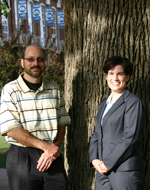Lisa Blue
Ph.D. Student
By Brian Connors Manke
Don’t be fooled by her last name. The most important color to chemistry graduate student, Lisa Blue, is definitely green.
When Blue was starting college at Missouri State as a pre-med student, she stayed for a summer session to get a chemistry course out of the way. Get it done and over with – like ripping off a Band-Aid.
Simple enough – but then came the unexpected. For the first time in college she was thoroughly challenged. She had to truly work at chemistry, and for a student with the drive and inquisitiveness that Blue possesses that was enough to get her hooked.
A master’s at Missouri State followed, as did a stint working at the Blackmon Water Treatment Plant in Springfield, Mo. – a job that impressed upon her the issue of clean water. “I was fascinated with this interaction between humans and our potable water resources. You may not think about what you’re doing when going about your daily business, but it’s going to have ramifications somewhere down the line,” Blue said.
 Blue knew that her academic pursuits were going to continue to tackle those issues. “I wanted to get involved in being a part of taking the bad things we put in the environment back out because I saw how it affects our air quality and our drinking water quality.”
Blue knew that her academic pursuits were going to continue to tackle those issues. “I wanted to get involved in being a part of taking the bad things we put in the environment back out because I saw how it affects our air quality and our drinking water quality.”
“I came here specifically because I had read David Atwood’s webpage and saw what he was interested in,” Blue spoke of her mentor and Professor in the Department of Chemistry at UK.
At the same time she was has interviewing with Jerry Atwood at University of Missouri’s doctorate program as well. Blue felt that department wasn’t the right fit, but UK was. After the fact, she figured out an interesting tidbit. “I didn’t know Jerry was David’s dad. I never knew the two Atwoods were related, let alone father and son,” Blue recalled still stunned and amused by the scenario.
When it comes to ‘green chemistry,’ Blue feels it is vital to have a two-pronged attack. Having scientists both looking for new and improved ways of reacting with the environment, and also being cognizant of what has already happened. “A few of us need to hold back from following the trend towards developing new green chemistry techniques and say ‘We’ve messed up a lot, and need to focus on fixing those problems already plaguing the environment as well by pursuing novel and more robust remediation methods,’” Blue suggested.
Blue is doing her part, and has been a research juggernaut. “Any project that was available – if I wanted to take a crack at it I could,” she noted. While she is making quite a name for herself in scientific circles, she is quick to give endless amount of credit to a specific UK resource, the Environmental Research Training Laboratory (ERTL).
Under the direction of Gail Brion, ERTL is a laboratory on campus that has scientists and a variety of equipment, and students are free to go there and discuss their projects with professionals like Trish Coakley and John May.
“Depending on what type of analyses you need, they actually train you how to use those instruments yourself. I had all these wonderful projects at my disposal, I had this laboratory, and I had help whenever I needed it. So, at the end of the day I knew I was walking out with publishable, defensible data – that was a huge goal for me,” Blue gratefully expressed.
That is in stark contrast to other facilities that Blue has dealt with prior to UK.
“When I did my master’s and bachelor’s, my research training on the instrument amounted to a limited experience with the help of another student. And that’s common. In hindsight, I did not have enough quality control to get good publishable results and that was just depressing after working on my masters for three years – but no such problem here.”
Plus, it is not simply people from one discipline that come through ERTL’s doors. “I’m not just working with other chemist, I’ve been working with chemical engineers, geologists, agriculturalists, physical geographers – I really love that cross-pollinization of ideas,” Blue said.
Having experienced the dynamic and nurturing environment that UK has provided, Blue hopes to use UK’s example as a blue-print or ‘green-print’ to take elsewhere.
“I want to find the ideal school where they are missing this ERTL component, because I would like to go to a school where they don’t have a strong environmental research program and build up a similar lab,” Blue detailed of her plans. “I enjoy teaching in the lecture setting, but the one-on-one time is priceless.”
Plus, Blue will always be searching for her next challenge, the next obstacle that stimulates and pushes her intellectual abilities, just like chemistry initially did that fateful summer. “There’s always a list of emergent contaminants that we need to worry about, there’s always something topping the list – whether it’s Bispehnol A showing up in bottles, or with nuclear power become a bigger deal – I’m sure that we’re going to be even more worried about radionuclear handling, disposal and remediation.”
“I want to be a part of that research, and I also wanted to be able to train other young scientists to follow in my footsteps and do that research as well.”
Those are shaping up to be some mighty big footsteps.
